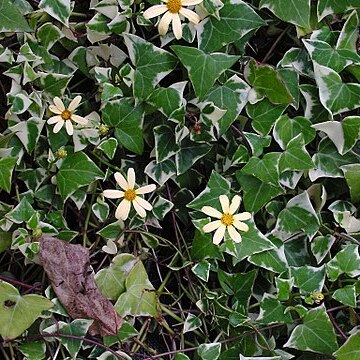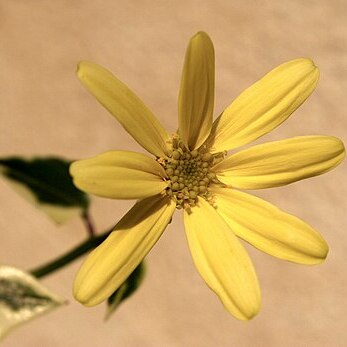Climber to c. 3 m high, glabrous. Leaves to c. 6 cm long, with petiole c. half of length; lamina ± triangular, with l:w ratio 0.9–1.2, with a basal lobe on each side; margin entire or with small teeth usually only near base. Capitula 1–3 per branch; calycular bracteoles 8–12, c. 10 mm long, c. 1.5 mm wide; involucre 9–11 mm long, c. 5 mm diam.; bracts c. 10. Florets numerous; ligulate florets c. 12; ligule 10–20 mm long, 8–10-veined, yellow. Achenes ± narrowly obloid, c. 2.5–3 mm long, pale brown, glabrous. Pappus persistence unknown, 7–8 mm long.
Perennial, herbaceous twiner, ± fleshy, glabrous. Stems up to 2.45 m long. Leaves ± deltoid, 45 x 80 mm, 3-lobed, hastate, lower 2 lobes spreading; petioles 15-30 mm long. Inflorescence a solitary or up to 3-headed corymb; peduncles axillary or terminal, up to 100 mm long; bracts conspicuous. Capitula radiate, disc yellow, rays (± 8) ± creamy yellow, conspicuous; involucre turbinate; bracts ± 12, 9-10 mm long; calyculus bracts ± similar to involucre. Flowering time all year, mostly Mar.-July. Cypselae cylindrical, 4.5 mm long, ribbed, glabrous.
Twining herb. Leaves deltoid-hastate in outline with 3 main lobes, the 2 lower lobes sometimes with a smaller tooth on lower margins. Heads radiate, rays 8; involucral bracts 12.9-10 mm long. Achenes glabrous. Flowers with creamy or buttery yellow rays, disc yellow.
Herbaceous, somewhat succulent climber. Leaves petiolate, sagittate. Flower heads radiate, large, mostly solitary, cream-coloured to pale yellow, conspicuously calycled.


